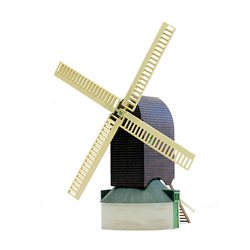There are a number of different options for attaching figures such as a horse and rider to a layout. Perhaps the...
No products
Product successfully added to your shopping cart
There are 0 items in your cart. There is 1 item in your cart.
Search Tips
What options do I have for motorising the waterwheel on a mill or the sails of a windmill?
There are several options for motorising the waterwheel on a mill or the sails of a windmill on a model railway layout. Here are a few:
Small electric motor: A small electric motor can be used to power the waterwheel or sails of a windmill. This motor can be hidden underneath the mill or mounted on the side. Alternatively, it may be possible to use a belt or gears to transfer the power from the motor to the wheel or sails.
Servo motor: Another option is to use a servo motor, this is a type of motor that can be programmed to move in a specific way. A servo motor can be used to turn the waterwheel or move the sails of the windmill. It can also be programmed to stop and start at certain points to create a more realistic effect.
Wind power: For modellers looking to integrate other electrical or engineering projects into a layout it is possible to use wind power to turn the sails. A small wind turbine can be attached to the layout, which will generate enough power to turn the sails. This option requires some additional planning and setup, but it can create a very realistic effect.
Hand-cranked: For a more traditional option, it may be possible to use a small compact hand-cranked mechanism to turn the waterwheel or sails. This option requires the modeller to turn a crank, which will transfer the power to the wheel or sails. It is a simple and low-tech option that can add some charm to a layout.
Ultimately, the method used is a matter of individual choice and will depend on the look the modeller is trying to achieve and the level of detail and complexity that a modeller will wish to add to their layout.
Click here to receive the tips weekly in your mailbox. You can unsubscribe at any time.









